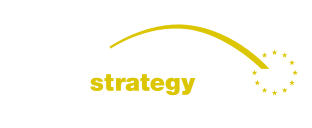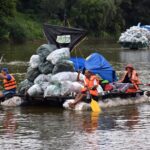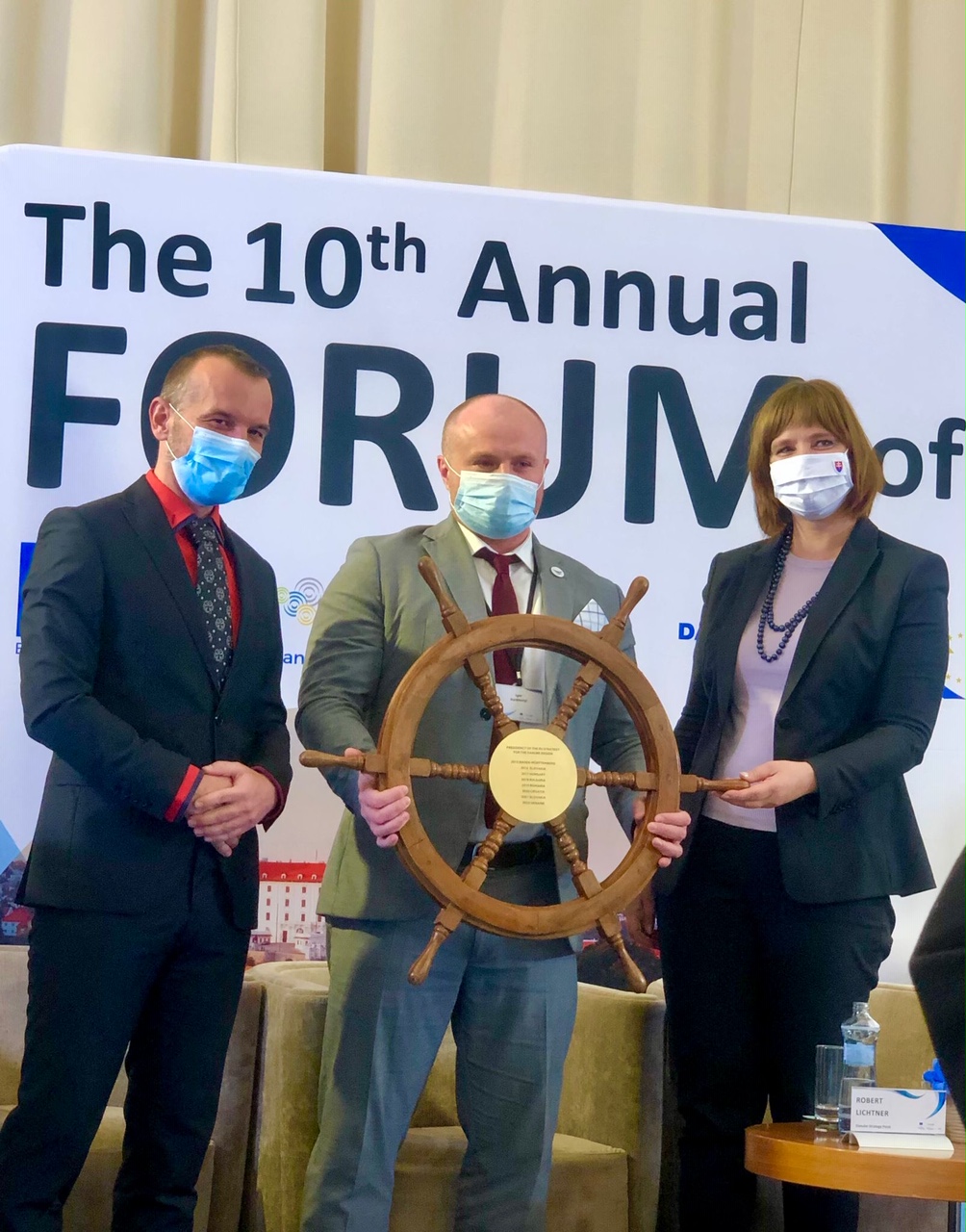Photo: Slovak EUSDR Presidency representative Michal Blaško, upcoming Ukrainian EUSDR Presidency representative Igor Korkhovyi and Slovak Deptuy Prime Minister Veronika Remišová at the Handover Ceremony of the EUSDR Steering Wheel (Photo taken by the DSP)
On 26 and 27 October 2021, the 10th Annual Forum of the EU Strategy for the Danube Region (EUSDR) was held in Bratislava in a hybrid format. The priorities of the Slovak EUSDR Presidency were in particular to improve cooperation between the countries involved in the Strategy, as well as thematic areas such as climate change, biodiversity protection, digitalisation and innovation.
Read more on the EUSDR Annual Forum in the sections below and in case you wish to gain a more in-depth insight into specific sessions, download the comprehensive summary report of the Annual Forum here.
The programme kicked off with a videoconference of ministers responsible for innovation and digitalisation, opened by Deputy Prime Minister Veronika Remišová. In her speech, she summarised the achievements of the Slovak EUSDR Presidency, in particular the embedding of the Strategy’s priorities in the EU funds programming process, the establishment of a task force for better involvement of young people and the support for the involvement of EU candidate and neighbouring countries in the management of the Strategy. She also underlined MIRRI’s (Ministry of Investments, Regional Development and Informatisation of the Slovak Republic) activities in the field of innovation and digitalisation, such as the finalisation of RIS3 and the promotion of smart cities.
Ms. Ratso, Deputy Director-General of DG RTD (DG for Research and Innovation), took the floor on behalf of the EC. She stressed in particular the need for investment in research and innovation to ensure economic transformation. Cooperation and exchange of experience within the Danube Region is key in achieving this. She also mentioned European initiatives aimed at ensuring the renewal and resilience of Member States, such as the ERA, the Digital Learning Action Plan, Horizon Europe missions and partnerships and the New European Bauhaus.
Representatives of the 14 EUSDR participating states then took the floor, concluding with a joint declaration expressing their commitment to make innovation and digitalisation one of the main priorities in the implementation of the EUSDR.
The event itself was subsequently opened by the Prime Minister of the Slovak Republic, E. Heger, who in his speech highlighted the role of macro-regional strategies (MRS) in connecting and collaborating EU Member States and non-EU Member States to address current challenges, including the green and digital transformation. He also highlighted the role of MRS in the area of EU enlargement. Cohesion policy has an important role to play in meeting the EUSDR objectives, with the preparation of the 2021-2027 programming period entering its final phase. He also appreciated that the UA will be the first non-EU country to take over the EUSDR Presidency (see 00:11:15 in the video below).
Commissioner Elisa Ferreira delivered a video message and stressed the role of cooperation in addressing current challenges, the role of the EUSDR now being more relevant than ever. She considers three areas to be key: innovation and digital transformation, the European Green Deal and embedding. Cohesion policy is to help mobilise resources for the implementation of EUSDR activities, and she believes that all relevant actors need to be involved in this process, within the framework of the partnership principle. She concluded by wishing the incoming Ukrainian EUSDR Presidency the best of luck.
The speeches were followed by the Head of the EC Representation in Slovakia Miko (00:28:20 in video below), who highlighted the good relations, trust and progress of the countries of the Danube Region, State Secretary Andreja Metelko-Zgombić (HR – previous EUSDR Presidency; 00:35:00) and Deputy Minister Igor Korkhovyi (UA – upcoming EUSDR Presidency from 1 November 2021 onwards; 00:43:00), who emphasised the role of macro-regional strategies for accelerating European integration.
During the plenary session, Minister J. Budaj emphasised the topic of biodiversity and water and forest management (1:08:00). This was followed by Mr N. Popens, Deputy Director General of DG REGIO, who highlighted the importance of the EUSDR in connecting actors in the green and digital transformation (1:18:00). Cohesion policy resources, including the Just Transition Fund, should be used to fill the legislative framework with content. He also mentioned the need to simplify implementation to attract young people, as 2022 will be the European Year of Youth. He also sees the importance of EUSDR in the area of EU enlargement. EIB and JRC representatives also delivered presentations, outlining their activities and opportunities to support EUSDR priorities (see video below at 1:56:00 and 1:33:00).
The first day concluded with the annual event of the Interreg Danube Transnational Programme (DTP), which provides resources and expertise for the implementation of EUSDR activities. A kick-off event for the 2021-2027 programme should take place next April, with the first calls expected in spring (see video below at 2:33).
The second day of the 10th EUSDR Annaul Forum kicked off with a panel on digital transformation and innovation. Presentations were dedicated to examples of successful projects in the Danube Region, having been supported from various sources (national and regional sources, ESF+, Interreg, Horizon Europe): Danube Alliance for SME Competitiveness, Innovation Express 2021, CINEMA, Restart_4Danube, Women in business and several projects of the Slovak Centre of Scientific and Technical Information: Knowledge Society, IT Academy, DRIVEN, Robocoop, HubIT, CE-Responsible (see video below at 00:12:44)
A parallel panel was dedicated to the involvement of young people in the EUSDR, including initiatives by EUSDR Priority Areas 9 and 10 and the announcement of the initiatives “Danube Youth Council” and “Danube Network of Youth Organisations”, see video below at 00:16:40.
This was followed by a panel on support to non-EU countries. The EC presented the Economic and Investment Plan for the Western Balkans, which aims at the economic development and revitalisation of the region in 6 key areas: sustainable transport, environment and climate, clean energy, digital future, private sector and human capital. The Roadmap also includes guidelines for the implementation of the Green Agenda for the Western Balkans. The MDGs here provide a unique platform for promoting cooperation, EU enlargement and the European Neighbourhood Policy, see video below at 02:16:30.
A parallel panel was dedicated to the threats and opportunities in biodiversity management, see video below at 02:17:37.
The final panel focused on the topic of EUSDR embedding, which is crucial especially in terms of funding for EUSDR activities. The Slovak EUSDR Presidency presented the achievements in this area, in particular the selection of the main EUSDR priorities to be incorporated into the Partnership Agreement and Operational Programme. The EC will subsequently assess the incorporation of the MRS into these strategic documents in the process of their approval and will continuously monitor the implementation of the MRS and issue regular reports, see video below at 04:39:50.
Finally, Deputy Prime Minister V. Remyshova handed over the symbolic Danube Region Strategy wheel to Igor Korkhovyi, Deputy Minister for Development of Communities and Territories of Ukraine. The Ukraine thus takes over the chairmanship of the Danube Region Strategy. The main priorities of the Ukrainian EUSDR Presidency will be the sustainable development of the Danube Region through decarbonisation and economic transformation and the development of human capital and labour markets, see video below at 05:59:10.




